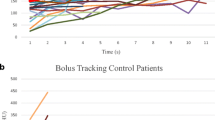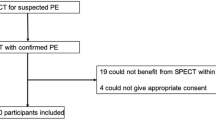Abstract
Purpose
Acute chest syndrome (ACS) is secondary to occlusion of the pulmonary vasculature and a potentially life-threatening complication of sickle cell disease (SCD). Dual-energy CT (DECT) iodine perfusion map reconstructions can provide a method to visualize and quantify the extent of pulmonary microthrombi.
Methods
A total of 102 patients with sickle cell disease who underwent DECT CTPA with perfusion were retrospectively identified. The presence or absence of airspace opacities, segmental perfusion defects, and acute or chronic pulmonary emboli was noted. The number of segmental perfusion defects between patients with and without acute chest syndrome was compared. Sub-analyses were performed to investigate robustness.
Results
Of the 102 patients, 68 were clinically determined to not have ACS and 34 were determined to have ACS by clinical criteria. Of the patients with ACS, 82.4% were found to have perfusion defects with a median of 2 perfusion defects per patient. The presence of any or new perfusion defects was significantly associated with the diagnosis of ACS (P = 0.005 and < 0.001, respectively). Excluding patients with pulmonary embolism, 79% of patients with ACS had old or new perfusion defects, and the specificity for new perfusion defects was 87%, higher than consolidation/ground glass opacities (80%).
Conclusion
DECT iodine map has the capability to depict microthrombi as perfusion defects. The presence of segmental perfusion defects on dual-energy CT maps was found to be associated with ACS with potential for improved specificity and reclassification.




Similar content being viewed by others
Data Availability
The data supporting the findings of this study are available upon request.
References
Fitzsimmons R, Amin N, Uversky VN (2016) Understanding the roles of intrinsic disorder in subunits of hemoglobin and the disease process of sickle cell anemia. Intrinsically Disord Proteins 4(1):e1248273. https://doi.org/10.1080/21690707.2016.1248273
Sachdev V, Rosing DR, Thein SL (2021) Cardiovascular complications of sickle cell disease. Trends Cardiovasc Med 31(3):187–193. https://doi.org/10.1016/j.tcm.2020.02.002
Sundd P, Gladwin MT, Novelli EM (2019) Pathophysiology of sickle cell disease. Annu Rev Pathol 14:263–292. https://doi.org/10.1146/annurev-pathmechdis-012418-012838
Gladwin MT, Vichinsky E (2008) Pulmonary complications of sickle cell disease. N Engl J Med 359(21):2254–2265. https://doi.org/10.1056/NEJMra0804411
MekontsoDessap A et al (2011) Pulmonary artery thrombosis during acute chest syndrome in sickle cell disease. Am J Respir Crit Care Med 184(9):1022–9. https://doi.org/10.1164/rccm.201105-0783OC
Stein PD, Beemath A, Meyers FA, Skaf E, Olson RE (2006) Deep venous thrombosis and pulmonary embolism in hospitalized patients with sickle cell disease. Am J Med 119(10):897.e7–11. https://doi.org/10.1016/j.amjmed.2006.08.015
Adedeji MO, Cespedes J, Allen K, Subramony C, Hughson MD (2001) Pulmonary thrombotic arteriopathy in patients with sickle cell disease. Arch Pathol Lab Med 125(11):1436–1441. https://doi.org/10.5858/2001-125-1436-PTAIPW
Hassan A, Taleb M, Hasan W, Shehab F, Maki R, Alhamar N (2023) Positive rate and quality assessment of CT pulmonary angiography in sickle cell disease: a case-control study. Emerg Radiol 30(2):209–216. https://doi.org/10.1007/s10140-023-02126-9
McCollough CH, Leng S, Yu L, Fletcher JG (2015) Dual- and multi-energy CT: principles, technical approaches, and clinical applications. Radiology 276(3):637–653. https://doi.org/10.1148/radiol.2015142631
Vlahos I, Jacobsen MC, Godoy MC, Stefanidis K, Layman RR (2022) Dual-energy CT in pulmonary vascular disease. Br J Radiol 95(1129):20210699. https://doi.org/10.1259/bjr.20210699
Bhalla M et al (1993) Acute chest syndrome in sickle cell disease: CT evidence of microvascular occlusion. Radiology 187(1):45–49. https://doi.org/10.1148/radiology.187.1.8451435
Tivnan P, Billett HH, Freeman LM, Haramati LB (2018) Imaging for pulmonary embolism in sickle cell disease: a 17-year experience. J Nucl Med 59(8):1255–1259. https://doi.org/10.2967/jnumed.117.205641
Dako F, Hossain R, Jeudy J, White C (2021) Dual-energy CT evidence of pulmonary microvascular occlusion in patients with sickle cell disease experiencing acute chest syndrome. Clin Imaging 78:94–97. https://doi.org/10.1016/j.clinimag.2021.03.018
Ballas SK et al (2010) Definitions of the phenotypic manifestations of sickle cell disease. Am J Hematol 85(1):6–13. https://doi.org/10.1002/ajh.21550
Vichinsky EP et al (2000) Causes and outcomes of the acute chest syndrome in sickle cell disease. National Acute Chest Syndrome Study Group. N Engl J Med 342(25):1855–1865. https://doi.org/10.1056/NEJM200006223422502
Gilyard SN, Hamlin SL, Johnson JO, Herr KD (2021) Imaging review of sickle cell disease for the emergency radiologist. Emerg Radiol 28(1):153–164. https://doi.org/10.1007/s10140-020-01828-8
Thieme SF, Johnson TR, Reiser MF, Nikolaou K (2010) Dual-energy lung perfusion computed tomography: a novel pulmonary functional imaging method. Semin Ultrasound CT MR 31(4):301–308. https://doi.org/10.1053/j.sult.2010.05.001
Gertz RJ et al (2023) Dual-layer dual-energy CT-derived pulmonary perfusion for the differentiation of acute pulmonary embolism and chronic thromboembolic pulmonary hypertension. Eur Radiol. https://doi.org/10.1007/s00330-023-10337-4
Foldyna B et al (2023) Pulmonary perfusion defect volume on dual-energy CT: prognostic marker of adverse events in patients with suspected pulmonary embolism. Int J Cardiovasc Imaging 39(7):1333–1341. https://doi.org/10.1007/s10554-023-02836-8
Si-Mohamed SA et al. (2023) Lung dual-energy CT perfusion blood volume as a marker of severity in chronic thromboembolic pulmonary hypertension. Diagnostics (Basel) 13(4). https://doi.org/10.3390/diagnostics13040769
Bird E et al (2023) Mapping the spatial extent of hypoperfusion in chronic thromboembolic pulmonary hypertension using multienergy CT. Radiol Cardiothorac Imaging 5(4):e220221. https://doi.org/10.1148/ryct.220221
Koike H, Sueyoshi E, Uetani M (2022) Diagnosis of chronic thromboembolic pulmonary hypertension using quantitative lung perfusion parameters extracted from dual-energy computed tomography images. J Thorac Imaging 37(4):239–245. https://doi.org/10.1097/RTI.0000000000000646
Perez-Johnston R et al (2021) Perfusion defects on dual-energy CTA in patients with suspected pulmonary embolism correlate with right heart strain and lower survival. Eur Radiol 31(4):2013–2021. https://doi.org/10.1007/s00330-020-07333-3
Porembskaya O et al. (2020) Pulmonary artery thrombosis: a diagnosis that strives for its independence. Int J Mol Sci 21(14). https://doi.org/10.3390/ijms21145086
Novelli EM, Gladwin MT (2016) Crises in sickle cell disease. Chest 149(4):1082–1093. https://doi.org/10.1016/j.chest.2015.12.016
Ilerhunmwuwa NP et al (2023) Prevalence and outcomes of pulmonary embolism with sickle cell disease: analysis of the Nationwide Inpatient Sample, 2016–2020. Eur J Haematol 111(3):441–448. https://doi.org/10.1111/ejh.14025
Author information
Authors and Affiliations
Corresponding author
Ethics declarations
Conflict of interest
Reginald F. Munden MD DMD holds stock in Optellum Ltd and Therabionics.
Uwe Joseph Schoepf MD received institutional research support and/or personal fees from Bayer, Bracco, Elucid Bioimaging, Guerbet, HeartFlow, Keya Medical, and Siemens.
Jim O’Doherty PhD was an employee of Siemens Medical Solutions USA, Inc.
The remaining of the authors has no conflict of interest to declare.
All co-authors have seen and agree with the contents of the manuscript and there is no financial interest to report.
Additional information
Publisher's Note
Springer Nature remains neutral with regard to jurisdictional claims in published maps and institutional affiliations.
Rights and permissions
Springer Nature or its licensor (e.g. a society or other partner) holds exclusive rights to this article under a publishing agreement with the author(s) or other rightsholder(s); author self-archiving of the accepted manuscript version of this article is solely governed by the terms of such publishing agreement and applicable law.
About this article
Cite this article
Chamberlin, J.H., Ogbonna, A., Abrol, S. et al. Enhancing diagnostic precision for acute chest syndrome in sickle cell disease: insights from dual-energy CT lung perfusion mapping. Emerg Radiol 31, 73–82 (2024). https://doi.org/10.1007/s10140-024-02200-w
Received:
Accepted:
Published:
Issue Date:
DOI: https://doi.org/10.1007/s10140-024-02200-w




